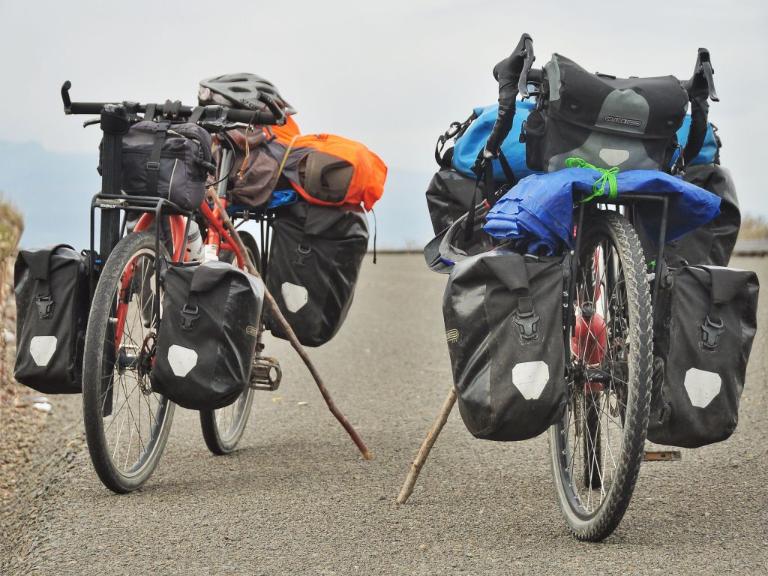The Costs of Bike Touring and Budget Management
Everyone dreams about traveling the world, but nobody has that kind of money. When you choose a bike as your vehicle, suddenly, the major costs disappear. It's possible to do a long-distance bike tour with less money. Let's see how much you need and how to travel by bike on a budget.
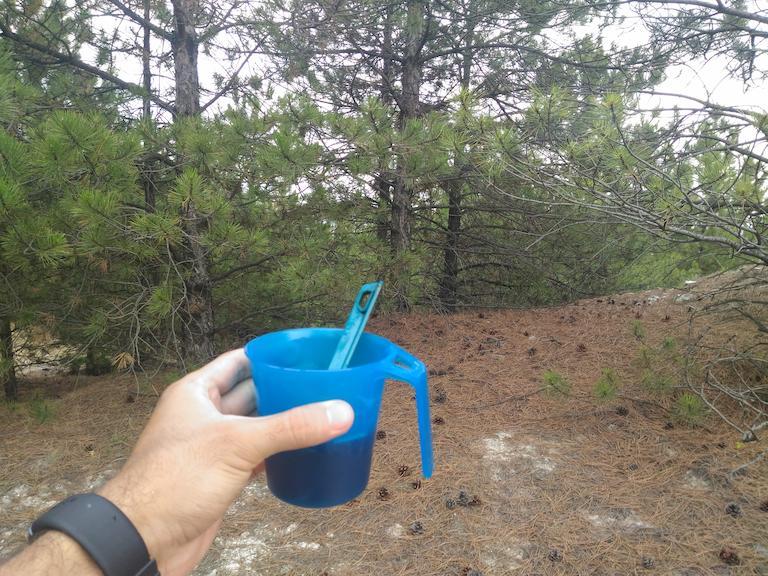
The Costs of Bike Touring
The costs can change considerably, depending on your style of travel.
If you do wild camp, cook your own meals, do preventive maintenance for your gear, and be careful along the way, the costs can be small. Otherwise, if you eat in restaurants, stay in hotels, abuse your gear, and live like a king, you need a lot of money.
There is a middle ground. Sometimes, you may want the comfort of a hotel; a comfortable bed, warm shower, or a sense of security. Staying in a hotel once in a while, eating in a small restaurant when you don’t want to cook, or buying a coffee while you wait for the rain to stop, is perfectly okay, as long as you don’t chuck your money around recklessly.
General Expenses
Bike Touring Gear Costs
The initial costs are high. Practically, you’ll live outside and you need to change your furniture to the equivalent of outdoor gear. The entire equipment can cost from $1,000 USD to $10,000 USD, including the bike. After your first tour, you’ll know exactly what you need, so don’t buy any expensive gear that you’ll regret, but, don’t go cheap on important gear either.
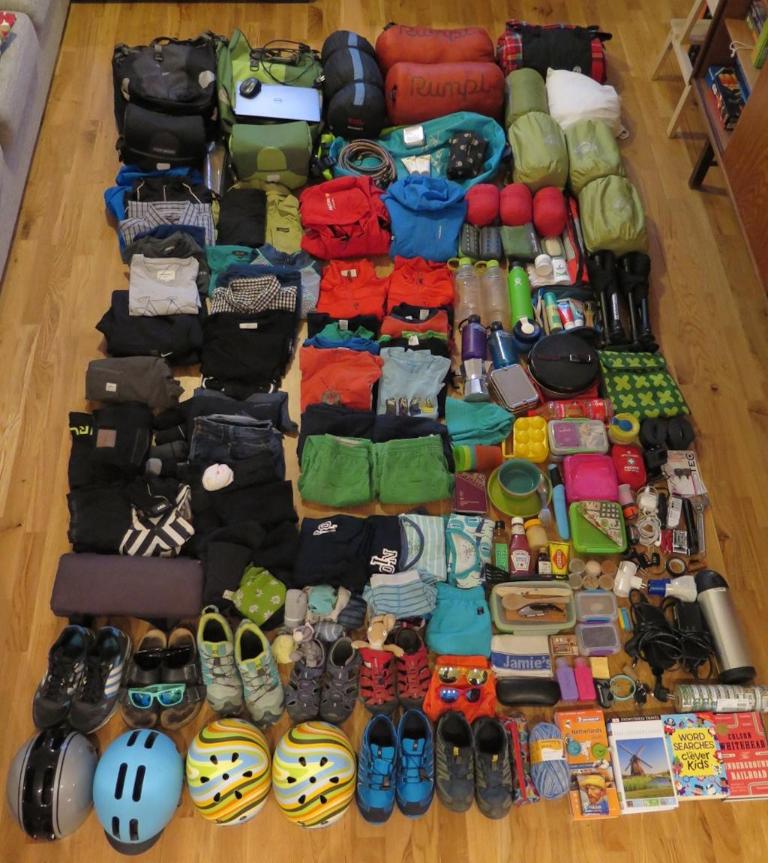
Some pieces of equipment play an important role in your safety and well-being, so, don’t skimp money on them. A good, warm sleeping bag against the freezing cold at night, a strong tent against the strong wind, a sturdy bicycle against the rough road, and a good helmet in case anything happens.
T-shirts, socks, and underwear will wear out quickly and need replacement. These don’t cost much, but you should still calculate them in your budget.
Transport Costs
Pushing on the pedals is free, but sometimes, you may have to go across seas, or you may just want to skip the boring parts.
Local transports are usually pretty cheap, ferries and trains are not expensive either, but they can add up fast.
You don’t need to use any of these methods of transport except planes and ferries to get across seas, but make sure you carry enough cash for unexpected public transportation.
Transporting bicycle by plane
Some airlines charge extra fees for large luggage such as your bike. Before buying a plane ticket, take your time to research a cheaper option. You may want to buy insurance for your bike because we heard some bad stories about bikes getting smashed during transport.
Transporting bicycle by ferry
If you are going to travel around the world, you may have to take some ferries to get across seas or gulfs.
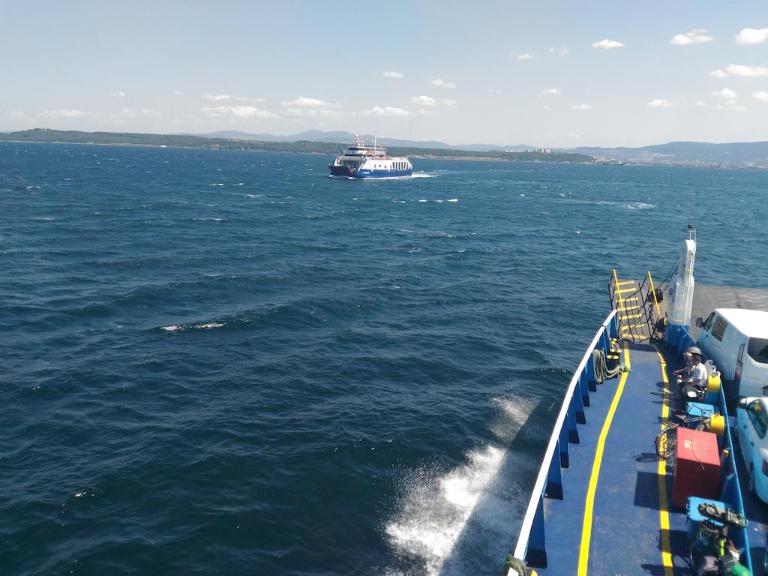
If hopping island to island sounds awesome, your wallet needs to be fat. A little research shows that some ferries cost as much as planes, and some ferries are as cheap as dirt.
Transporting bicycle by bus
If you are not carrying a full bike repair kit with you, you’ll need to take a bus to the nearest city when some major repair is needed. It’s usually cheap, but don’t take my word for it. Hitchhiking reduces this cost marginally.
Transporting bicycle by train
High-speed trains don’t take bikes as luggage, and with their bulky load, you don’t have a chance. Old school trains are still popular in most eastern countries, and they add a nice, smoky colour to your journey.
Visa Costs
Visa fees largely vary, depending on your nationality and the country you are visiting. Some countries require more work for getting a visa, so, you may have to pay more than you expected. Do your research beforehand and adjust your budget accordingly.
Healthcare & Insurance Costs of Bicycle Touring
Most injuries while bike touring are minor, and first-aid is enough. Major problems are rare and probably won’t cost more than the insurance itself. Like everything, you can prevent most illnesses and accidents by just being careful and looking after yourself. But most of us buy insurance “just in case”.
As for healthcare, university clinics are cheaper; some of them are even free. If you need more than a band-aid, look for them.
Insurance for your bike might be necessary in case of theft or accidents, but again, it may cost more than the bike itself in the long run, and you may have to prove that your bike is actually stolen.
It’s up to you to calculate your risks and decide whether or not to buy insurance.
Daily Expenses on a Bike Tour
Food Costs
It’s possible to live on less than $5 per day. In some countries, you can buy a pound of pasta for literally a dime. Of course, you are not going to eat pasta all the time. You’ll want to BBQ, taste local food, or eat street food, and this will increase food costs.
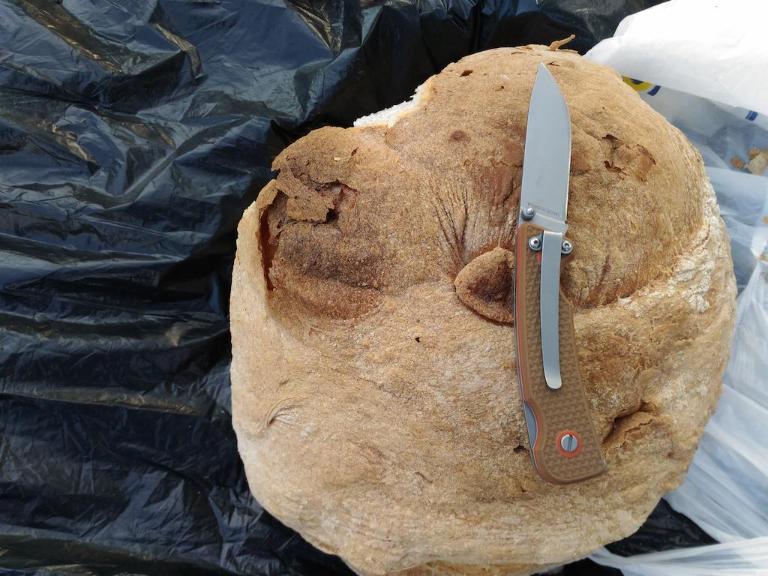
A camping stove and a pot is your best friend if you want to reduce your food costs. This way, you can wild camp whenever you want, and cook your own meals for cheap. Bread is an awesome source of calories that you don’t need to cook, and it’s cheap unless you’re in Europe.
Carrying fresh food on a long-distance bicycle tour is difficult, but you have to take the necessary vitamins to function properly. A box of vitamin pills comes in handy if you can’t find fresh vegetables.
Water Costs
Tap water is risky to drink, but you’ll have to fill your bottles from gas stations from time to time. Bottled water is cheap, but considering that you need a gallon of water every day, it adds up quickly.
The best solution to this is natural springs. If water flows continuously, you can assume it’s clean. If you are going to remote areas, I strongly suggest you bring a water filter to filter creek/lake water. You can also use it to filter tap water. This way you’ll reduce your bottled water costs.
In Southeast Asia, most water sources are contaminated with parasites, so be extremely careful with what you drink. If you don’t use a filter, boil the water to kill bacteria and other organisms before drinking.
Accommodation Costs
Long-distance bike touring is not a type of vacation, so paying for luxury accommodation is out of the question. But, even youth hostels or paid camping can add up to a large cost.
You can completely eliminate the accommodation cost by wild camping every night. This reduces the overall costs marginally. Sometimes, you may have to stay in a hotel to rest while you are sick, or just to re-organize your equipment and have a nice, warm shower.
What do you need money for, if you travel on a bike with a tent?
Dorothee Fleck
There are other alternatives for accommodation, such as CouchSurfing and Warmshowers. But you have to contact the host beforehand to let them know about your visit and introduce yourself. Out of these platforms, some people, mostly in the Middle East, will invite you to stay at their homes and feed you like their own child.
Unexpected Expenses
On a long-distance bike tour, some of your equipment will wear out, some of them will get lost, and some components of your bike will need replacement. It’s best to think about it, because it may end up eating up a large part of your budget.
Repair and Replacement Costs
Bike touring and camping gear are prone to regular wear and tear, especially the ultralight ones, which aren’t made to last. Even if you are careful, the rain and mud will get into your bike’s tiniest holes and break something, eventually.
Tires, tubes, brake pads, the chain, and cables need regular replacement, because of wear and tear. Besides those, rims, hubs, pedals, the seat post, and the headset may need repair or replacement from time to time.
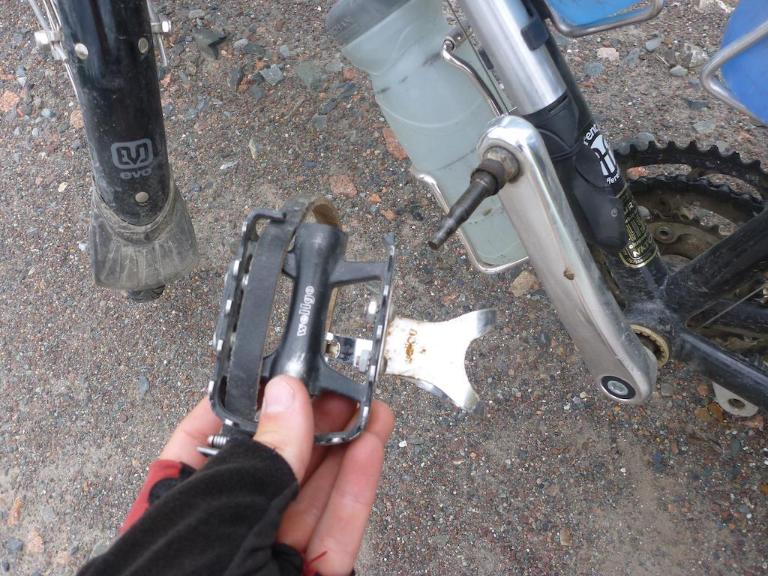
The unexpected failure of shifters and derailleurs, the bent dropout piece and rims, broken spokes, rack, and bottle holder, and even a cracked frame due to vibration is possible. You should also consider possible accidents too.
Your clothes and camping equipment may need some stitching, taping, or replacing. The tent may get punctured, shoes will wear out, and t-shirts will be discoloured from the sun. All of these costs should be considered while budgeting.
Lost or Stolen Equipment
You should make it a habit to check if you left something behind before you take off every time you stop. It may look like Obsessive Compulsive Disorder, but it’s a good practice.
Forgetting the helmet and gloves beside natural springs, losing the lighter while cooking dinner, stray dogs taking your shoes while you sleep, thief monkeys stealing your camera, dropping water bottles or even more equipment on rough road surfaces from vibration, leaving the phone or navigation device on the campground, and someone stealing your bike and gear while you are shopping or using the restroom is very possible.
Thieves are everywhere, even the nice people who invited you into their homes for the night may rob you. I’ve heard some bad stories.
You really don’t want to lose any of your equipment, even a lighter; it’s demoralizing, so look after your stuff.
Budgeting for Bike Touring
If you can prepare and stick to a spending plan, you’ll know how much you need in total for your planned bike tour. But without knowing how much you are going to spend, it’s impossible to come up with a reasonable budget. If you read the previous section about costs, you pretty much already have an idea about how much you need.
Now, take a pen and paper, and start writing your income and expenses. Every source, every bill, every spending, everything.
Some expenses are listed here, but there might be more:
- Rent
- Utilities
- Electric
- Water
- Gas
- Waste disposal
- Phone bills
- Internet bills
- Cable TV
- Loan payments
- Student loans
- Car loans
- Mortgage
- Medical debt
- Personal debt
- Insurance
- Car Insurance
- Health Insurance
- Liability Insurance
- Renter’s insurance
- Home Owner’s Insurance
You’ll see that some of them are unnecessary, and the list can be reduced. Once you have the complete list of your income and expenses, change your mindset.
Change Your Mindset
Accepting that you are a nomad with a bicycle is the first step. You don’t have a stream of money anymore, and you can live pretty well without much money. Somewhere out there, someone lives every day without money, without a home. And so can you. You just need to differentiate between “needs” and “wants”. Travelling without money doesn’t mean living under the bridge and trash-diving. It means that you can travel without a constant income.
I saved my loans through University and left home with about £7000. This easily lasted more than 4 years. A diet of bread and bananas, sleeping rough, and focused, disciplined asceticism mean you can travel most of the world very cheaply.
Alastair Humphreys
And here is a good, calculated, and tested hypothesis: Even if you live in a developing country, you can live with 10% of your annual income for a full year if you remove the unnecessary expenses. By unnecessary, I mean house rent, bills, debts, anything except food and basic needs.
Let’s go to the next step.
Pay Off Your Debt
Debt is a huge burden and an obstacle to your journey. First, you need to get rid of any debt to start saving money. It’s your first priority. If you change your mindset, it’s not hard to pay off your debts.
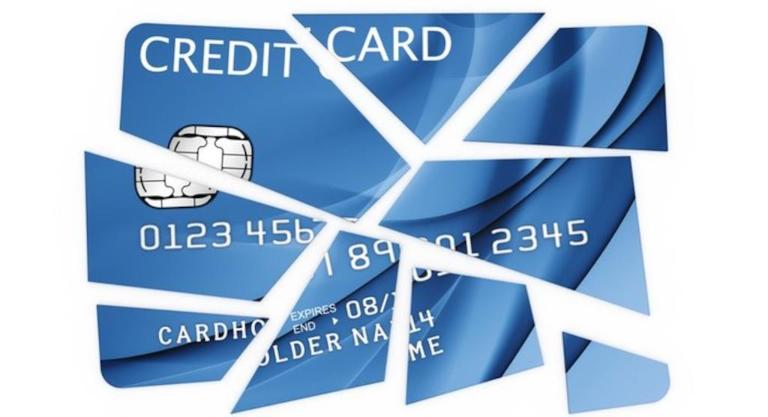
If you are paying a mortgage, it may take longer to close the debt, but I’m not going to be the one who tells you to sell your house. You can include the mortgage payments in your budget and automate them while you are touring. But at least, you can cancel your credit cards, and subscriptions, and reduce your bill count.
Save Money for Bike Touring
Once you pay off your debt and reduce monthly bills, it’s easy to save money. Sometimes, you may feel weak and spend your savings to buy “the new thing” but I advise you to hold yourself. If you put your money in your savings account and consider it as an “expense”, you’ll think the money is gone and you won’t think about spending it, because it doesn’t exist.
That’s it!
Bike Touring on a Low Budget
At the beginning of this article, I said the bike touring gear can cost from $1,000 USD to $10,000 USD. An average of $5,000 USD is enough to buy quality gear, but it’s perfectly possible to buy gear for marginally less than that. I’m a living example of that, all of my equipment cost less than $1,000 USD, including the bike.
Of course, spending a little bit more money on the important gear is always recommended.
Finding Cheap Bike Touring Gear
You can find second hand but good quality gear from other bicycle tourers. Some people constantly upgrade their equipment and sell the old ones even if they aren’t “old” yet. You can find them on Craigslist, eBay, or in some Facebook groups dedicated to selling and buying secondhand bike touring equipment.
Retailers make great sales on special days, and AliExpress is always providing cheap gear, with free shipping! The quality of gear from China may not be good, so always buy the important gear from quality brands. I wouldn’t trust any bike, rims, chain, rack, and handlebar that comes from China. Tents and other camping gear might be OK, but they should be branded and must have lots of good reviews.
Make Your Own Bicycle Touring Gear
Many people make their own gear. Panniers and small bags are common, but some people even make their own sleeping bags and tents! Of course, it’s not wise to go on a bike tour around the world with a handmade tent on the first try, but, if you test the equipment and do your own quality assurance, why not?
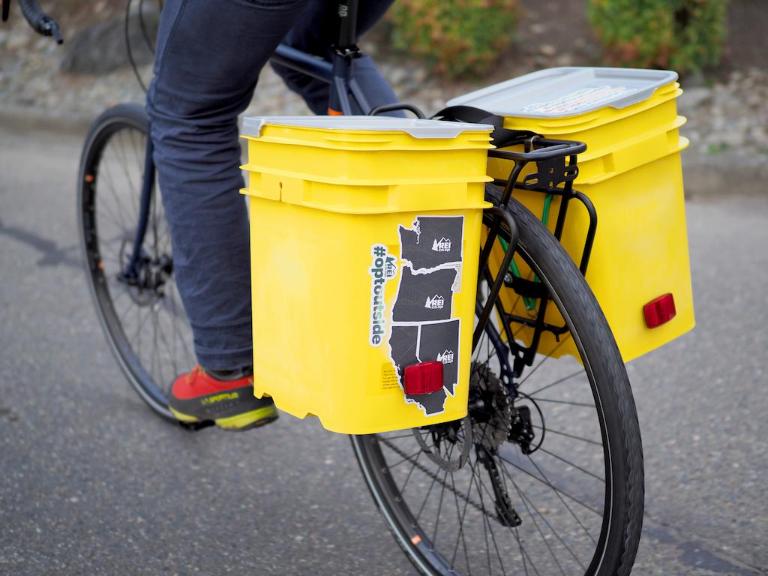
Less is More
I knew that, but I couldn’t hold myself. It’s some kind of sickness. I thought I should have every possible gear that I might need at some point on the road; I eventually didn’t need them and they are now in a box under my bed. Actually, only basic gear is all you need; the rest is luxury.
What you really need for cycle touring:
- A bike and a system to carry gear
- A sleeping system to survive the night
- Basic Clothing
- Basic Cookware
- Hygiene products
- Navigating system
Anything else is not essential to life, but comfort.
Bicycle Touring without Money
It’s not common in the bike touring community, but it’s possible to go on a bike tour with no money. Back in the 80’s, people travelled without money in their pockets, around the world, for the sake of wanderlust. It’s different now, but the concept is the same. You can eat, sleep and travel in exchange for your help, expertise, or just for being a decent human being.
Volunteering
WWOOF is a worldwide, organic farming volunteering organization. You can join any WWOOF organization and work on organic farms as you travel around the world. Some farms will cover your bus and plane tickets, and almost all of them provide food and accommodation while you work there.
HelpX is a classified site that lists available work around the world in exchange for food and accommodation, sometimes even money. HelpX lists farms just like WWOOF, but it also lists other work available at local businesses, such as hotels, restaurants, constructions, etc.
Sponsorship for Bike Touring
If you are not an influencer in the cycling industry, it’s hard to find a sponsor. Vendors don’t care about your “epic” journey, they care about if you can increase their sales. If you have an audience, you can get some free equipment, even money for your expenses. Even then, you are practically working for the vendor, and it’s not fun.
I could have comfortably done the whole thing – kit, camping, bike, flights – for 7k. Having sponsors gave us more cash but imposed constraints and tied us into certain itineraries.
Fearghal O’Nuallain
If you have an audience, you don’t need to beg for sponsorship, you can monetize it with affiliate marketing, which we’ll discuss in the next section.
Making Money while Bike Touring
It’s the 21st century, and you don’t have to be in an office to work. You can carry your workstation in your pocket. And the best part is that you don’t have to be tech-savvy.
Fiverr & Upwork
There is a massive amount of work available on Fiverr and Upwork, and if you have any skill, you can earn huge amounts of money while you are travelling by your bike.
Fiverr is a gig-based job site. You list a gig for any price that is a multiple of $5, and when someone buys your service, you deliver it and get paid. Upwork is more like an hour-based job site, but you can set a fixed price for your work. Fixed price is better because it’s hard to work on an hourly basis while you are travelling.
Some of the gigs you can do on these platforms:
- Freelance Writing
- Proofreading & Editing
- Graphic Design
- Website Building
- Social Media Management
Actually, it’s silly to make a list, you can do any kind of work you want, you can provide any kind of service you want, you can set any price you want, you can work in any time frame you want, and cash out anywhere you want.
Adventure Photography
I know, it’s a saturated job field, but still, you can earn money by selling stock photos. Here is a small list of sites that pay money for photos:
- Alamy
- Fotolia
- Getty Images
- iStock
- Adobe Stock
- Dreamstime
- ShutterStock
- 123RF
Playing Street Music to Make Money
If you are talented, why not? A guitar is a little bit heavy to carry on a bike, but some people don’t mind it.
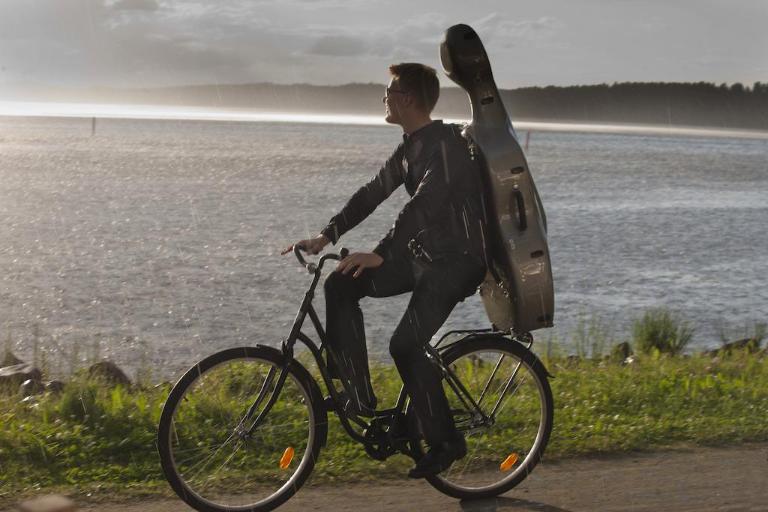
A harmonica is another option with less weight.
Blogging and YouTubing
Blogging about your cycle touring journey
Don’t know what to write about? You are a traveller! You can write about your journey! Travel blogs are popular now, although, it’s hard to get traction and earn money from them, it’s still a good idea. You can monetize your blog with advertisements, affiliate products, or by selling e-books that you wrote.
Publishing your journey videos on YouTube:
As with blogging, you can publish your adventure on YouTube and make money from advertisements and affiliate marketing. It’s more involved than blogging because you need a computer to edit your videos and upload them to YouTube.
Online Business
If entrepreneurship is in your blood, you can start an easy-to-do online business and earn money while you travel. Dropshipping, software-as-a-service, or your expertise as an online service, are good ways to earn money while you travel on your bike.
Teach English Online
You can teach English online as an ESL Teacher (English as a Second Language teacher). Some websites that pay you to teach English, just search them on Google!
Working in Local Businesses
You can work in restaurants and hostels by cleaning dishes, as a busboy/busgirl, or sometimes as a receptionist. If you are a strong man, you can work as a construction worker. It’s hard and dangerous but pays well.
You can also work on farms as a fruit picker, vegetable harvester, or seed planter. I don’t think it pays well, but I’m sure it’s fun.
Spending Money while on a Bike Tour
Finally, you’ve saved enough money for your long-distance bike tour. If you spend it without keeping any record, you’ll run out of money pretty soon. You should keep receipts and write your expenses daily. This way, you’ll know exactly how much you spent, and reduce your spending to balance your budget.
Limiting your Budget
Daily Budget
I set a daily limit for my spending, it’s $5. Depending on the country, you can set a higher or lower limit. If you spend less than the limit, it’s good. But if you exceed the limit, don’t worry, it’s not bad either. You’ll probably spend less the next day.
Monthly Budget
If you follow your daily limit, you won’t exceed the monthly limit. But unexpected expenses can eat your wallet and thus your plans will go down the drain.
If you don’t reach the limit, it’s great! Occasionally, you’ll want to taste local food or buy something that you don’t really need. You can use this extra, but the more you save, the more you can travel.
Total Budget
It won’t be good if you run out of money before you finish your bike tour. It’s important to follow your daily and monthly limits to avoid returning home early or living only on pasta until you return.
You should also consider the price of the plane ticket to your home country in your budget even if you plan to ride back with your bike.
Always carry extra cash in separate places, just for emergencies.
Keeping Your Money Safe while Touring
You should keep your money safe, not only from thieves but also from the banks and their politics.
Keeping the Cash Safe
Divide your cash and hide it in your seat post, handlebar, and panniers. You can stitch some hidden pockets on your underwear and socks.
If you encounter robbers, don’t hesitate to use your pepper spray, but if you can’t do that, empty your pockets, give them some cash and bargain for your bike. It’s impossible to imagine a situation like that, but some bikers went through that awful experience and they said they couldn’t even move.
In any case, have a backup plan.
Bank Accounts and ATM Cards
ATMs can swallow your card, the magnetic strip could be overwritten, your bank may block your account for unreasonable things, or you may just lose the card. Because of this, you should carry multiple ATM cards from different banks.
Most banks have security protocols that block accounts and/or ATM cards if they are used in foreign countries, so, make sure you notify your bank about your trip.
Hide one of your ATM cards on you in case your equipment gets stolen.

